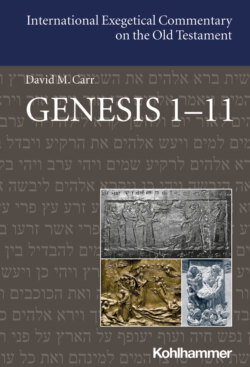Читать книгу Genesis 1-11 - David M. Carr - Страница 28
На сайте Литреса книга снята с продажи.
Conclusion: Divergent Patterns Spanning Gen 1:1–2:3
ОглавлениеLooking back at the broader whole, numerous commentators have noted broader patterns binding together Gen 1:1–2:3. Probably the most common has been the observation, often associated with Herder, of a balance between the four creation acts spread across days one through three and those spread across days four through six.118 Some of the correspondences can be indicated as follows:
| Day One: creation of light | Day Four: creation of heavenly “lights” (sun, moon, stars) |
| Day Two: splitting of primeval ocean through the heavenly plate | Day Five: creation of creatures that live in the sea and birds flying across the heavenly plate |
| Day Three: (1st act) revealing of earth by gathering waters and then | Day Six: (1st act) creation of land animals and creepers and then |
| (2nd act) Making earth sprout seed bearing plants and trees with fruit trees | (2nd act) creation of humans as God’s image and giving humans plants and tree fruits for food (animals are given seed-bearing plants for food) |
This pattern highlights how the eight acts spread over six days described in Gen 1:3–31 are distributed into two sets of three days, with the last day of each three-day set, days three and six, having two acts. All six of these days are understood here as a block, concluded by a sixth day marked separately as “the” sixth day (1:31a), and standing over against the seventh day on which God ceased from the work of all preceding six days.
At the same time, Odil Hannes Steck has argued persuasively that the acts spread across days two through six manifest an even tighter relationship with each other, with the whole framed by the creation of day and night on day one (1:3–5) and the climax of the day structure on day seven (2:1–3). He argues that the core of the creation account is divided between an initial description of God’s creation of cosmic spaces (heavenly plate, sea, earth in 1:6–13) before describing God’s corresponding population of those spaces with stars and creatures (1:14–31). Both halves of the creation account, so Steck, are oriented toward the ultimate creation of humans, with the description of cosmic spaces starting with spaces not inhabited by humans (heaven and sea) and then climaxing with the human habitat of earth and the description of God’s population of those spaces starting with sea and air creatures before climaxing with humans.
| Spaces of Creation—Life Realms (farthest from human to nearest) | Filling of Spaces(farthest from human to creation of humans) |
| Time Thematic | |
| Act 1: heavenly plate | Act 4: Making and installation of heavenly “lights” in the heavenly plate |
| Life Thematic | |
| Act 2: gathering of waters—sea(revealing earth) | Act 5: Creation of sea creatures (and air creatures) |
| Act 3: plant/fruit-bearing earth | Act 6: Creation of animals (eating plants)Act 7: Creation of humans (eating plants and fruits) |
Steck admits that this observed pattern in 1:6–31 does not have the same balance as the 3+3 day scheme advanced by others. Nevertheless, he argues that it avoids the strange parallel in the 3+3 pattern between the making of the plate on day two and the creation of sea and air creatures on day five, and it better fits the actual sequence of the creation account as it builds, step by step, toward the creation of humans as its crowning element. Most particularly, Steck’s proposal highlights the human-oriented organization of the quite similarly-structured creation acts in 1:6–31.119
That said, Steck’s grouping of the creation of day and night (1:3–5) with the Sabbath that it prepares for (2:2–3) does not acknowledge the way God’s ceasing from work in 2:2–3 relates to all six days that precede, 1:3–5 along with days 2–6. All six days follow a similar pattern that contrasts with that in 2:2–3, and all six are concluded on “the” sixth day in 1:31. In this sense, Steck’s overall proposal, though rightly recognizing some kind of a special connection between days one and seven, clashes with the overall Sabbath structure (six days of “work,” מלאכה in 2:2, one day of rest) that day one makes possible and day seven concludes.
In sum, Gen 1:1–2:3 seems characterized by multiple structural frameworks—highlighted by Herder, et al. on the one hand and Steck, et al. on the other.120 Each framework connects with important aspects of the text, and no framework fully accounts for all of the existing text.
